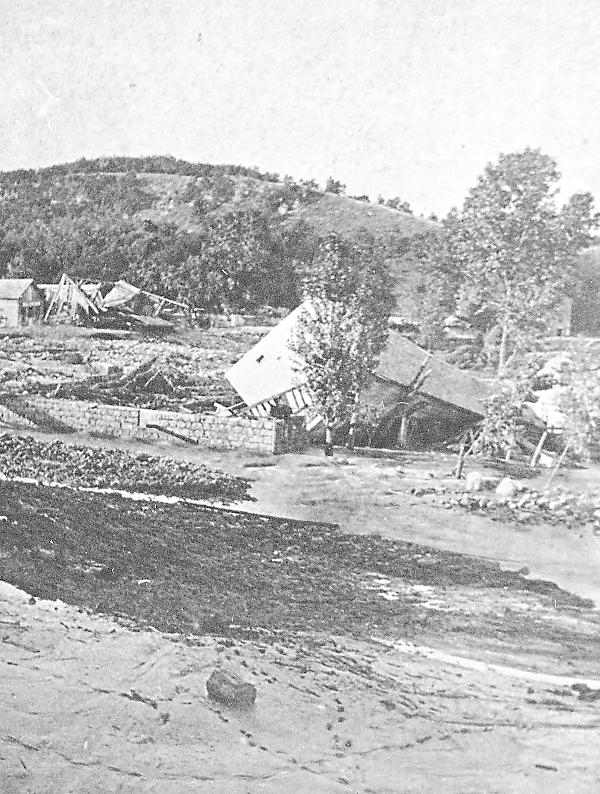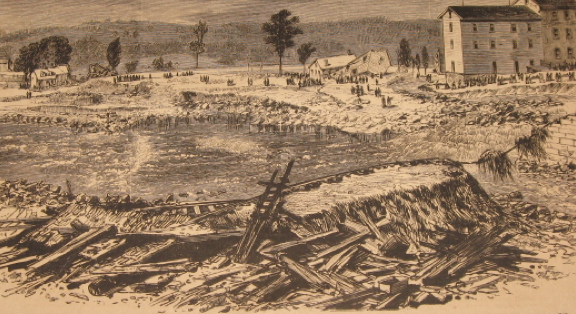The Tragic Rockdale Flood of 1876
Rockdale, Dubuque county, Iowa

When historians were preparing the 1880 History of Dubuque County, the memory of July 4, 1876, was still vivid for county residents and journalists. It was not the celebration of the nation’s centennial that was so unforgettable. It was the quick and fatal flood, especially in the village of Rockdale but also in the city of Dubuque a couple miles to its north.
The scene of the disaster was in a ravine among the bluffs west of Dubuque which, said an early newspaper account, “nature had formed for a water-course.” A dam and flour mill had been erected in 1834 to take advantage of the power of the water in Catfish Creek and redirect those waters, and the village was established to take advantage of the business generated by the flour mill. The ravine between the bluffs was some 80 rods across. A stone bridge and another bridge of some 200 feet in length that carried the tracks of the Illinois Central Railroad ran above the ravine bluff to bluff.
The placement of the village of Rockdale proved successful until July 4, 1876. Rain began on the national holiday at 11 p.m. and fell in torrents for an hour. The bar-tender and customers in the Rockdale saloon began to worry. The saloon sat on the east side of the ravine, and a “channel had been worn between the saloon and the right bank, through which the waters rushed with a force and significance that defied escape in that direction.” In the flashes of lightning, those still awake in the saloon witnessed an avalanche of debris from buildings torn from the hillside. The rushing water had snapped the steel that held the Illinois Central Railroad bridge. In turn, it fell against buildings, carrying them with it down through the ravine.
In the saloon was the proprietor, his wife and children, the bar-tender, a gardener and his family seeking refuge, and six other men. Only four men survived. One was a neighbor who saw his own house containing his family carried away. Mechanic, hotel owner, post master—all the village residents were caught in the powerful water. The bar-tender, Charles Timmesch, survived by jumping from an upper story of the saloon to the roof of the store and post office next door. When that building started shaking beneath him, he stripped and plunged into the water to try swimming for the shore. A strong swimmer, he reached the shore and made his way to a neighbor’s house to warn all not yet caught in the water.
Another saloon survivor, a guest, awoke upstairs in bed, floated out a window and managed to cling to a treetop until morning. Several other village residents were saved by treetops. Three brothers, aged, 14, 11, and 5 also had floated out a second story window. The 11-year-old caught hold of a tree’s crown and then snagged his little brother. The eldest grabbed another tree further along the water’s course, but the three brothers were within shouting distance of one another and stayed in communication throughout the night. The brothers (and the trees) survived.
For a mile downstream the wreckage—material and human– was strewn along the banks of the stream. Thirty-nine people from the village of Rockdale had died.
The city of Dubuque also experienced flooding that night. There were fewer human fatalities there but tragedy was felt nonetheless. In a small home, a “shanty,” on the flats, a young couple slept with their baby beside them in a cradle. By the time the parents were awakened by cold water reaching them in the bed, the water had already upended the cradle and the baby had already drowned. With the child’s body, the parents sought shelter with relatives on higher ground.

Image Source: NWS
Source: SHSI: History of Dubuque County, Chicago, 1880.
